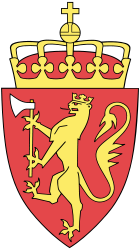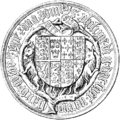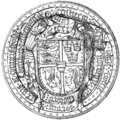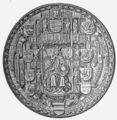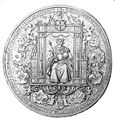- Coat of arms of Norway
-
Royal Arms of the
King of Norway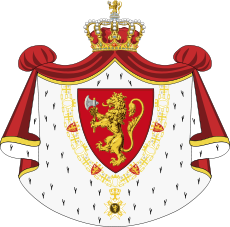
Details Armiger King of Norway Adopted 1280; elaborated in 1905 Crest The crown of the King of Norway (on a royal crown a demi-lion rampant or, crowned and bearing an axe with blade argent) Escutcheon gules, a lion rampant or, crowned and bearing an axe with blade argent Orders Order of St. Olav Other elements An ermine mantling Purpure The coat of arms of Norway is a crowned, golden lion rampant holding an axe with an argent blade, on a crowned, triangular and red escutcheon. Its elements originate from personal insignias for the royal house in the High Middle Ages, thus being among the oldest in Europe. In Norway, the motif of the coat of arms is often called den norske løve; literally translated, “the Norwegian lion”.
Contents
Royal coat of arms
The coat of arms of the royal house as well as the Royal Standard uses the lion design from 1905. The shield features the insignia of the Royal Norwegian Order of St Olav around it.
The shield is framed by a royal ermine robe, surmounted by the crown of Norway.
History
Magnus Barefoot (1093–1103) was the first Norwegian king to use an heraldic lion in his standard. Håkon the Old (1217–1263) placed the lion on escutcheon.[citation needed] In 1280 a crown and a silver axe was added to the lion in King Eirik Magnusson's insignia. The axe is the martyr axe of St. Olav, the weapon said to have killed him in the Battle of Stiklestad in 1030.[citation needed]
The design of the Norwegian arms has changed through the years, following changing heraldic fashions. In the late Middle Ages, the axe handle gradually grew longer and came to resemble a halberd. The handle was usually curved in order to fit the shape of escutcheon (or the changing union quarterings) preferred at the time, and also to match the shape of coins. The halberd was officially discarded and the shorter axe reintroduced by royal decree in 1844, when an authorised design was instituted for the first time. In 1905, the official design for royal and government arms was again changed, this time reverting to the medieval pattern, with a triangular escutcheon and a more upright lion. The painter Eilif Peterssen was responsible for the design. The present design was introduced in 1937, but slightly modified with royal approval 20 May 1992.
The coat of arms is always to be displayed surmounted with the royal crown. During the political and constitutional conflicts of the late 19th century, republican anti-union liberal forces could use an uncrowned shield as an emblem, as can be seen on the banner of Kristiania Folkevæpningssamlag in the Oslo City Museum.[citation needed] During World War II the Quisling regime continued to use the lion coat of arms, although another coat of arms, bearing the Nasjonal Samling emblem, was also used concurrently. In 1943, the design of the lion was modified, and the royal crown was replaced with an open medieval type of crown. The legitimate Norwegian government continued to use the coat of arms with the royal crown during exile.
According to the rules of heraldry, any design is acceptable and recognizable as the arms of Norway, provided it fits the blazon "gules a lion rampant or, crowned and bearing an axe with blade argent".
The Norwegian official blazon: "Ei upprett gull-løve på raud grunn med gullkrone på hovudet og gullskjeft sylvøks i framlabbane".
Stand-alone national coats of arms
In spite of the various unions that Norway has been party of throughout the centuries, the coat of arms of the Norwegian nation was simultaneously also depicted separately in domestic contexts. In line with the conventions of heraldry, the design of the heraldic elements vary with each individual depiction, but the most tangible and consistent elements of evolution are outlined below. Note that the design of the crown surmounting the escutcheon is anachronistic, as no separate heraldic crown was devised for Norway until the 19th century.
Coat of arms Description Dates Used 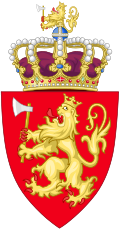
In 1280 a crown and a silver axe was added to the lion in King Eirik Magnusson's insignia. The axe is the martyr axe of St. Olav, the weapon said to have killed him in the Battle of Stiklestad in 1030.[citation needed] c. 1274–Late Middle Ages 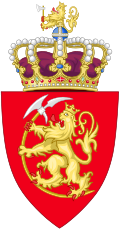
In the late Middle Ages, the axe handle gradually grew longer and came to resemble a halberd. The handle was usually curved in order to fit the shape of escutcheon (or the changing union quarterings) preferred at the time, and also to match the shape of coins. Late Middle Ages–1844 
The halberd was officially discarded and the shorter axe reintroduced by royal decree in 1844, when an authorised design was instituted for the first time. 1844–present -
Union and royal coat of arms of the Union between Sweden and Norway from 1844 to 1905. The full achievement in the royal flag of Norway.
-
New design introduced by the Quisling government during the German occupation of Norway. From a postage stamp issued in 1944.
Coats of arms of regents
-
Seal of Jemtland granted by King Magnus VI of Norway in 1274.
-
Seal of Haakon V of Norway (reigned 1299 - 1319).
-
Union arms of Haakon VI as king of Norway and Sweden, c. 1380, from the Gelre armorial.
-
Union seal of Eric III of Pomerania as king of the Kalmar Union, 1398. The coat of arms of Norway in the inescutcheon.
-
Sigilum secretum of Christian I, 1457-1460. The coat of arms of Norway dexter base.
-
Seal of Christian III (reigned 1534 - 1559). The coat of arms of Norway sinister chief.
-
Coat of arms of Christian III as it appeared in the first Danish-language Bible, 1550.
-
Coat of arms of Frederick II. Engraving by Jens Bircherod, 1581.?
-
Coat of arms of Johann der Junge, duke of Sønderborg 1580, in the chapel of Sønderborg Castle, Denmark. The arms of Norway chief dexter reflect Johann's title as heir to Norway.
-
Eric XIV of Sweden added the Norwegian and Danish arms to the Swedish national coat of arms (the two lower quarters). This was one of the main events leading to the Northern Seven Years War
-
Coat of arms of Frederick IV of Denmark and Norway, as depicted in the Long Hall of Rosenborg Castle. The coat of arms of Norway sinister chief.
External links
- The Norwegian Government on the coat of arms
- On the general use of the arms (Norwegian)
- Use on stamps (Norwegian)
- Pictures of older versions of the arms (German)
- The oldest preserved example (from 1292) (Norwegian)
- Penny issued 1285, the earliest known official use
- History of the arms (English)
- General information and legal definitions of the flag and coat of arms of Norway from the University of Oslo
Categories:- Norwegian coats of arms
- National coats of arms
- National symbols of Norway
Wikimedia Foundation. 2010.

